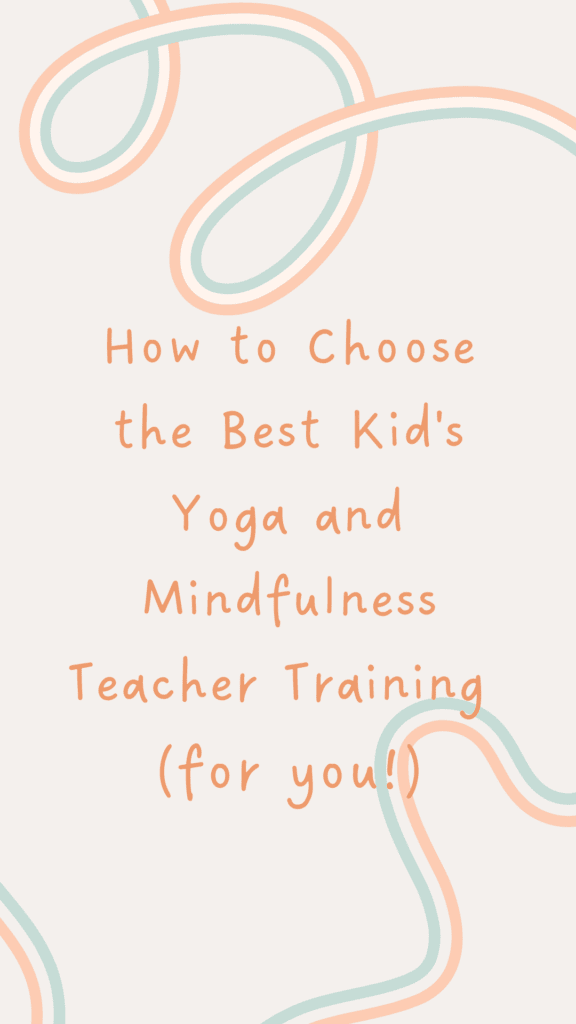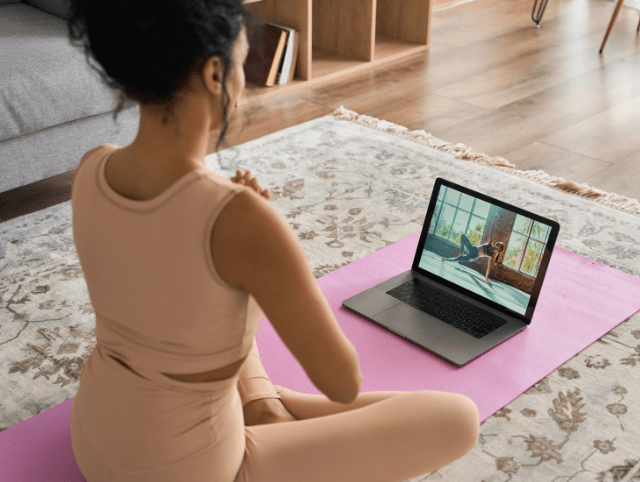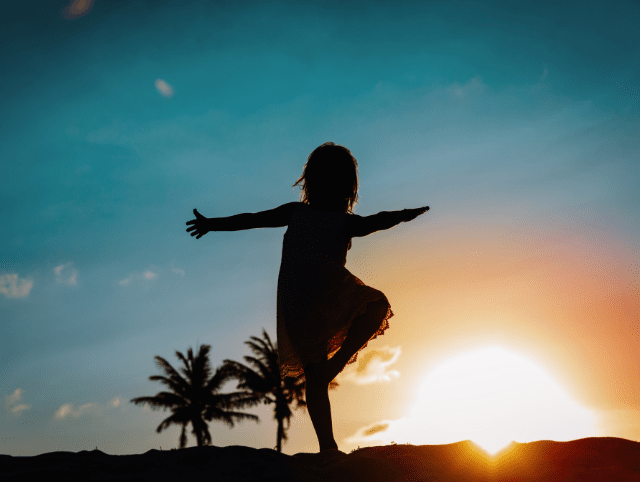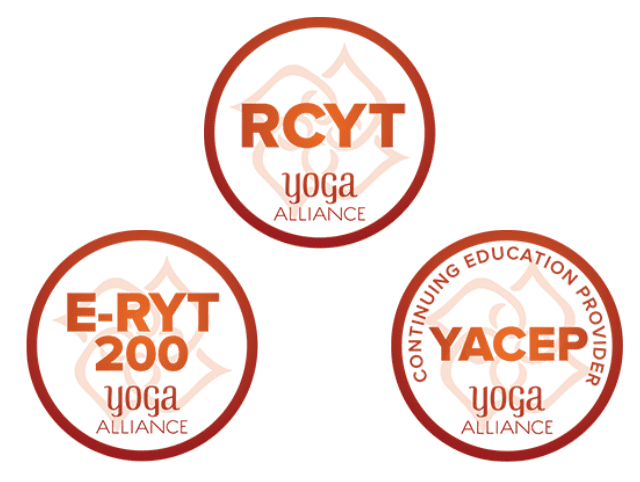If you are wondering how to become a children’s yoga teacher, you need to start thinking about what kind of teacher training you will want to take. A good teacher training program is essential in order to become a successful kid’s yoga teacher.
There are quite a few options out there right now, including many that are online, so it may be hard to know what will work best for you and your needs.
Since there are so many to choose from, you want to make sure the one you decide has the material, support, and teaching methods that will work best for you.
Here are a few things you might want to consider before jumping into the top program listed on Google.
What to consider in a children’s yoga teacher training program
- In person or online
- The instructor(s) and their experience/background
- Teaching methods or philosophy of the program
- Yoga Alliance continuing education credits
- Length of time needed for the certification
- Materials and sample lessons included
- Amount of support provided by instructors or community members during and after the program
- Cost

If you are ready to become a kids yoga teacher, it’s important to invest in a good teacher training program to get you started on the right foot and with plenty of tools and ideas.
Being aware of these factors should help you decide what type of program you would like to invest in.
Below, we go over some considerations for each of these factors, and list some excellent programs that you can take a look at. In the end, it’s important to find something that you resonate with, and that will help lead you to success in teaching kid’s yoga!
Should I take an in person or online teacher training program?
In person trainings pros and cons
In person classes are a lot of fun, and they are especially great if you are a beginner to yoga. Being in person helps you learn the poses safely with an instructor who can ensure you are using proper alignment.
In person trainings are also energizing and a great way to meet new people and form quality connections with other like-minded teachers. You also get to try out the games with a group, learn partner poses, and feel how a class is taught from beginning to end.
However, in person teacher trainings are usually a lot more expensive, and you often have to figure in travel costs as well, unless you happen to have a local company that is doing a training near you.
Recommended in person children’s yoga teacher trainings:
Online kids yoga courses pros and cons
Online teacher training programs for kids yoga are a lot more common now than they were just a few years ago. There are some really high quality programs, and they are a lot more affordable often because most of them are self paced courses that have a lot less overhead cost on the company’s end.
Online courses are great because you don’t have to travel, you can learn from teachers all over the world, and you can make connections with a lot of people all at once.
You will also often get a lot more resources and lesson plans available to you right away in an online course platform.
Online programs are most often go-at-your-own-pace courses, but some have scheduled Zoom calls for the training. Some have a combination of both!
Self-paced trainings are often great for those with a tight schedule, or if you are in a time zone that is different from the trainers.
They are also good for people who want to get the training done quickly, or conversely, for those that need a little extra time to complete the course.
The cons of online training courses are that you don’t often get the same energy of excitement as you do in a group of people in the same space. It may be harder to learn the poses if you are new to yoga, and it may be hard to keep a good schedule if the program is self paced.

Recommended online self-paced kid’s yoga teacher programs
- Ultimate Kids Yoga and Mindfulness Leadership Certification – Go at your own pace, but with additional live community calls twice monthly for deeper enrichment. This is a wonderfully robust certification with 45 hours of training in all areas of teaching yoga and mindfulness to kids and teens and tons of ready made resources.
- Pretzel Kids Yoga – A 12 hour course with lesson plans, plus branding and marketing tools to help you start teaching yoga with their association if you choose.
- Cosmic Kids – the YouTube sensation of Cosmic Kids Yoga teaches a self paced course full of fun stories and tons of creative poses based on her highly popular kids yoga videos.
Recommended kid’s yoga teacher training programs with set live stream classes to attend
- Little Flower Yoga : A variety of training programs (Levels 1, 2, 3 and full) with dates to attend zoom classes, online coursework, and a community feel.
- Yoga Ed: a well established yoga program that prides itself on being fit for the classrooms, Yoga Ed has a variety of courses all with live scheduled calls and an online platform
Who will my instructor be, and do they have a lot of experience teaching kid’s yoga?
It’s important to know and take a look at who your class instructors are. You can teach yoga to kids in studios, in classrooms, at school functions, for birthday parties, in fitness centers, libraries, and more. All of these spaces and places require a little different intent and knowledge to successfully teach a class of yoga to kids.
Make sure that you find a teacher training program that gives you ideas and lesson plans that can work for the types of classes that you hope to be teaching.
Will you get a teacher who has knowledge and experience teaching in one area or one age group, or do they have a wide breadth of experience for ages, levels, and locations?
If you plan to teach in a school setting or secular space, does your instructor have experience with classrooms and behavior management?
Or do you need someone who can lead you in the more philosophical and spiritual side for teaching in studios with a focus on the Yoga Sutras?
Also, will they be able to share that experience with you directly?
Maia, the leader of Kumarah Yoga Teacher Training courses, has taught in preschools, orphanages, special needs centers, studios, and public schools for over 10 years. She has the most experience in public schools and classrooms, but has tons of experience overall and has worked with kids yoga teachers in a variety of different settings.
Be sure to do some research on your own to find out about the lead trainer or instructor for whichever courses you are interested in to find out if they will have experience in the area you plan to teach.
In the Ultimate Kids Yoga and Mindfulness Certification, you get to watch many hours of Maia’s actual classes with kids in them. They are real, unedited, non-scripted classes with kids who attend her class in school.
You get to see real life examples of classes that are messy, have struggling students, and tricky to manage. But with these you’ll see how Maia manages the behavior, keeps the class motivated and moving, and even sometimes makes mistakes but keeps on going!
What are the teaching methods or philosophy of the children’s yoga teacher training course?
This is something that can be hard to tell from a sales page for a teacher training course. Most courses and trainings will tell you what age groups you can teach, how many poses and games you’ll learn, and what the benefits of yoga for kids are (which you probably already know).
For those courses that do share philosophy and teaching techniques, it’s usually very vague or filled with key phrases like “trauma- informed” or “social-emotional learning,” which are obviously very important.
But how do you know if the content matches the intent?
Look for examples of lesson plans, teaching techniques, or proof of experience in these areas to know that the program will sufficiently teach these important subjects.
Kumarah Yoga is rooted in trauma-informed teaching practices because Maia teaches at a school with high rates of trauma-affected students. She has attended many school-based programs on how to teach with a trauma informed lens, how to teach social skills, how to be inclusive and accepting of kids with all identities, and how to teach to kids with all types of disabilities and needs.

Many of these learned teaching techniques are passed on to the trainees in the Ultimate Kids Yoga and Mindfulness Certification. There are whole lessons on trauma-informed teaching, how to avoid power struggles, including students with disabilities, teaching to the autistic child, and developing students’ social emotional skills.
Furthermore, positive and proactive classroom management techniques are taught throughout the whole course. It is planned from beginning to end to help teachers consider how they will teach effectively, not just what content they will teach.
This method of learning how to teach well is essential to Kumarah Yoga’s philosophy of teaching yoga to kids: it’s not just about the yoga. We teach kids essential life skills through yoga and mindfulness, we don’t just teach them the yoga poses.
We develop kids as whole people, with movement, thought, fun, mindfulness, leadership, self-reflection, and community.
Courses that teach from a trauma-informed perspective for kid’s yoga and mindfulness:
Will I receive Yoga Alliance continuing education credits, and do I need them to teach kids yoga?
You do not need a specific certification or license to teach yoga to kids, at least in most countries at this time.
However, many people like to have the “credentials” of a Yoga Alliance certification. If you have a 200 hour (adult) yoga certification registered through Yoga Alliance, you can then go on to attain a Registered Children’s Yoga Teacher (RCYT) label with an additional 95 hour certification program through an approved school.
There are not too many programs that qualify for the 95 hour certification with Yoga Alliance because it is honestly not necessary. You do not need the 200 hour adult-focused certification before you can teach kids, and the 95 additional hours are not even necessarily going to be very useful if you plan to teach yoga to kids in schools, libraries, at community centers, or anywhere with larger groups.
The 95 hour program qualifications do not include class management requirements and so they don’t help you learn how to manage groups of kids, which is an essential part of most kid’s yoga teaching jobs.
If, however, you want to increase your credential hours on Yoga Alliance because you are already registered, or you want to add continuing education credits, you may want a program that gives you CEU’s with Yoga Alliance. It can be useful to bolster your credentials with certain studios or schools that like to see how much experience and training you have had.

How long will it take for me to become a fully certified kid’s yoga teacher?
Many kids yoga programs have different amounts of Yoga Alliance “CEU’s” that you can receive with their courses, especially since many of them are online and go at your own pace. These will then indicate how long it will take to complete the course and become certified.
If you are able to choose an online course that has a robust community and a very active lead trainer, you may find yourself able to move through the course quickly with the motivation that those bring.
- The Ultimate Kids Yoga and Mindfulness Certification course currently qualifies as 30 hours of continuing education credits with Yoga Alliance. Maia is available in the Circle community group online (like a private Facebook group but with more awesome features) and does live calls twice a month to help her community stay on track.
- Pretzel Kid Yoga offers 12 hours of continuing education credits with Yoga Alliance and an online Facebook group for support.
- Yoga Ed offers a 95 hour RCYT online teacher training course with live weekly calls to stay on track.
- Rainbow Yoga offers 150 hours of continuing education credits with Yoga Alliance, 50 hours if you do a smaller course. Livestream options available.
- Little Flower Yoga offers a 95 hour RCYT online course, along with smaller ones. Optional continuing support community available.
What materials, lesson plans, and printable or physical resources are included in the training program?
If you are planning to start teaching yoga to kids in schools, studios, libraries, or even at birthday parties, it’s a good idea to have a decent amount of lesson plan ideas at your fingertips because you get started.
Visual yoga cards are also a very important part of teaching yoga to kids, and if you don’t have physical cards, a set of digital cards will do great. You can print them out and laminate them, or use them in slideshow presentations for your classes.
Kumarah Yoga’s Ultimate Certification comes with over 120 kids yoga pose cards, a dozen fully scripted lesson plans, partner pose cards, meditation scripts, attention signals, breathing exercise cards, class planning templates, workbooks, and so much more. All of it ready for you to print and use immediately, and with lifetime access.
Other trainings offer materials and course manuals as well, some of them come with the course, some are available in a separate subscription based package, and others are meant to be purchased separately or are only available for a limited time.
How much support is provided by instructors or community members during and after the kid’s yoga teacher training?
Online kids yoga teacher training are a great choice for people who can’t attend a live training. But what if you need a little more support and motivation or instruction from a teacher?
The live stream schedule courses may be a good choice for you, but if you can’t make the schedule work, you’ll need to find a course that has an instructor who is available and open to questions and extra help.
Maia not only runs the Circle group live calls for the Ultimate Kids Yoga and Mindfulness Certification, she asks the community what it is they need before choosing the topic for each one. The theme of the call is carefully considered to fit the needs of the current trainees and their students.
Plus, all live group calls leave plenty of time and space for brainstorming new ideas, problem solving, and strengthening teaching skills.
Additionally, Maia has an optional Coaching Program that you can join to deepen your teacher training and ensure that you get one-on-one support and practice teaching time while you go through the teacher training certification.
This added coaching can be an invaluable way to boost your confidence, increase your classroom management skills, and help you on the path to becoming a successful teacher, no matter where you plan to go.
What is the upfront and overall cost of the kids yoga teacher training course?
With such a variety in kid’s yoga teacher training courses, it’s no surprise that there is a wide range in price that you can expect to pay when getting certified to teach yoga to kids.
The teacher training program price may vary depending on the size of the company, the number of employees, the country they are located in, and a variety of other factors. Less money doesn’t always mean better value, but neither does more money signify increased worth.
The question isn’t really what does the program cost, but how much are you willing to spend?
Will the course bring you knowledge, experience, value, community, and a path forward?
Will it expand your view of kid’s yoga and mindfulness, and create an energy in you to continue to grow and teach?
No matter what you spend, make sure you choose a program that you feel is right for you, and that will be an investment towards your future in the career of yoga and mindfulness for kids.
Cost of kids yoga and mindfulness teacher training programs:
(prices and hours subject to change)
- Ultimate Kids Yoga and Mindfulness Certification – $397 (30 hours, online)
- Ultimate Kids Yoga and Mindfulness Certification with Coaching – $597 (55 hours, online)
- Yoga International – $129 (4 hours, online)
- Pretzel Yoga – $495, then 49/month (12 hours, online)
- Kidding Around Yoga – $695 (14 hours, in person)
- Rainbow Yoga – $617 (16 hours, in person)
- Cosmic Kids Yoga – $395 (20 hours, online)
- Yoga Ed – $799 (95 hours, online)
- Little Flower Yoga – $3200 (95 hours, online or in person)
- Rainbow Yoga – $1129 (150 hours, online)
Again, the price and the value it suggests are not always equal, depending on your needs. Do your research and make sure to consider all of the factors listed above carefully.
This is an investment into your career, the health and wellbeing of your children or students, and your own life path. Choose wisely, and know that hopefully you will be able to take several training courses over time.
Maia has taken at least a half dozen different kid’s yoga training programs, and plans to continue to educate herself with more training in the future. As we well know and try to teach our students, we never stop learning and growing!

